Impact-Resistant ABS 3D Printer Filaments
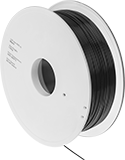 | |||||
Bumps, scrapes, and falls won’t damage these tough ABS filaments. Known for their durability, they absorb impact without cracking or breaking, and won’t degrade when heated. Use them to print tool handles, storage cases, and other parts that are handled or dropped frequently. These filaments are a good place to start if you’re experimenting with printing impact-resistant parts.
Use with a fused filament fabrication (FFF) 3D printer. These filaments have a high melting point and must be printed onto a heated bed. Without it, parts will cool too quickly and warp. These filaments also release fumes as they are printed, so use an enclosed printer or a fume exhauster to ventilate them.
SMA ABS filaments have a styrene additive that makes them easier to print and reduces warping during cooling. These filaments also form strong bonds between layers, so prints will not split apart. For heavy impact, use polycarbonate ABS filaments. The polycarbonate adds strength to printed parts.
Carbon-fiber-filled ABS filaments make rigid parts that are difficult to bend and break. Their parts can also be threaded and machined more easily than ABS filaments without a filler. Fiberglass-filled ABS filaments make parts that are stronger and less likely to warp or shrink than ABS filaments without a filler. Carbon-fiber- and fiberglass-filled filaments are abrasive, so you should use them with an abrasion-resistant nozzle. They will wear out other nozzles.
Static-dissipative filaments make parts that protect equipment from electrostatic shocks by diverting electrostatic discharges in a controlled way. Use them to create tool handles, tote trays, enclosures, and other parts that are used near sensitive electronics. To adjust the surface resistivity of your printed part, change the temperature of your printer’s extruder. As the extruder’s temperature increases, the printed part’s resistivity will decrease.
Filaments rated UL 94 V-0 meet strict flammability standards. Use them to create holders, guards, housings, and other parts that protect sensitive, flammable equipment and machinery.
Tensile strength is the best measure of a filament's overall strength. Similar to the stress applied on a rope during a game of tug-of-war, it's the amount of pulling force a material can handle before breaking. A higher rating means a stronger filament. A tensile strength of 5,000 psi and above is considered good; 12,000 psi and above is excellent.
Maximum exposure temperature is the point at which a printed part will begin to deform. Above this temperature, your printed parts will start to lose structural integrity.
Spool | ||||||||||||
|---|---|---|---|---|---|---|---|---|---|---|---|---|
| Dia., mm | Printing Temp. | For Printer Bed Temp. | Tensile Strength | Surface Resistivity, ohms/sq. | Max. Exposure Temp. | For Min. Nozzle Dia., mm | Dia., mm | Dp., mm | Wt., g | Choose a Color | Each | |
ABS Plastic | ||||||||||||
| 1.75 | 220° to 240° C 428° to 464° F | 100° to 110° C 212° to 230° F | 6,090 psi (Good) | __ | 90° C 194° F | 0.25 | 195 | 75 | 1,000 | 00000000 | 000000 | |
| 2.85 | 220° to 240° C 428° to 464° F | 100° to 110° C 212° to 230° F | 6,090 psi (Good) | __ | 90° C 194° F | 0.25 | 195 | 75 | 1,000 | 00000000 | 00000 | |
SMA ABS Plastic | ||||||||||||
| 1.75 | 240° to 260° C 464° to 500° F | 100° to 120° C 212° to 248° F | 4,300 psi (Poor) | __ | 71° C 160° F | 0.4 | 200 | 55 | 750 | 00000000 | 00000 | |
| 2.85 | 240° to 260° C 464° to 500° F | 100° to 120° C 212° to 248° F | 4,300 psi (Poor) | __ | 71° C 160° F | 0.4 | 200 | 55 | 750 | Black | 00000000 | 00000 |
Carbon-Fiber-Filled ABS Plastic | ||||||||||||
| 1.75 | 220° to 240° C 428° to 464° F | 100° to 110° C 212° to 230° F | 6,670 psi (Good) | __ | 76° C 169° F | 0.4 | 195 | 55 | 750 | Black | 00000000 | 00000 |
| 2.85 | 220° to 240° C 428° to 464° F | 100° to 110° C 212° to 230° F | 6,670 psi (Good) | __ | 76° C 169° F | 0.4 | 195 | 55 | 750 | Black | 00000000 | 00000 |
Fiberglass-Filled ABS Plastic | ||||||||||||
| 1.75 | 230° to 245° C 446° to 473° F | 95° to 110° C 203° to 230° F | 9,862 psi (Good) | __ | 89° C 192° F | 0.4 | 198 | 62 | 750 | Black | 00000000 | 00000 |
ABS Plastic—Static-Dissipative | ||||||||||||
| 1.75 | 220° to 240° C 428° to 464° F | 100° to 110° C 212° to 230° F | 8,410 psi (Good) | 107-109 | 97° C 207° F | 0.4 | 200 | 75 | 750 | Black | 0000000 | 000000 |
| 2.85 | 220° to 240° C 428° to 464° F | 100° to 110° C 212° to 230° F | 8,410 psi (Good) | 107-109 | 97° C 207° F | 0.4 | 200 | 75 | 750 | Black | 0000000 | 000000 |
ABS Plastic—UL 94 V-0 | ||||||||||||
| 1.75 | 220° to 240° C 428° to 464° F | 100° to 110° C 212° to 230° F | 6,520 psi (Good) | __ | 95° C 203° F | 0.4 | 200 | 75 | 750 | Black | 00000000 | 00000 |
| 2.85 | 220° to 240° C 428° to 464° F | 100° to 110° C 212° to 230° F | 6,520 psi (Good) | __ | 95° C 203° F | 0.4 | 200 | 75 | 750 | Black | 00000000 | 00000 |
Polycarbonate ABS Plastic—UL 94 V-0 | ||||||||||||
| 1.75 | 265° to 285° C 509° to 545° F | 110° to 120° C 230° to 248° F | 8,700 psi (Good) | __ | 125° C 257° F | 0.4 | 200 | 75 | 750 | Black | 0000000 | 00000 |
UV- and Impact-Resistant ASA 3D Printer Filaments
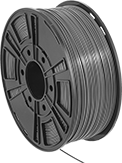 | ||
Best for outdoor use, parts made from these ASA filaments are UV resistant, so they won't warp or crack from prolonged sun exposure. They’re also durable, so they absorb impact without breaking and won’t degrade when heated.
Use with fused filament fabrication (FFF) 3D printer. These filaments have a high melting point and must be printed onto a heated bed. Without it, parts will cool too quickly and warp. These filaments also release fumes as they are printed, so use an enclosed printer or a fume exhauster to ventilate them.
Tensile strength is the best measure of a filament's overall strength. Similar to the stress applied on a rope during a game of tug-of-war, it's the amount of pulling force a material can handle before breaking. A higher rating means a stronger filament. A tensile strength of 5,000 psi and above is considered good; 12,000 psi and above is excellent.
Maximum exposure temperature is the point at which a printed part will begin to deform. Above this temperature, your printed parts will start to lose structural integrity.
Spool | |||||||||||
|---|---|---|---|---|---|---|---|---|---|---|---|
| Dia., mm | Printing Temp. | For Printer Bed Temp. | Tensile Strength | Max. Exposure Temp. | For Min. Nozzle Opening Dia., mm | Dia., mm | Dp., mm | Wt., g | Color | Each | |
ASA Plastic | |||||||||||
| 1.75 | 235° to 255° C 455° to 491° F | 90° to 110° C 194° to 230° F | 6,520 psi (Good) | 95° C 203° F | 0.4 | 200 | 75 | 1,000 | 00000000 | 000000 | |
| 2.85 | 235° to 255° C 455° to 491° F | 90° to 110° C 194° to 230° F | 6,520 psi (Good) | 87° C 188° F | 0.4 | 198 | 78 | 1,000 | 00000000 | 00000 | |
High-Strength Impact-Resistant Polycarbonate 3D Printer Filaments

Create strong, durable parts that carry heavy loads and absorb blows and other impact without cracking or breaking. Made of polycarbonate, these filaments are stronger and resist heat better than other impact-resistant filaments, such as those made from ABS or ASA.
Use with a fused filament fabrication (FFF) 3D printer. These filaments have a high melting point and must be printed onto a heated bed. Without it, parts will cool too quickly and warp. These filaments also release fumes as they are printed, so use an enclosed printer or a fume exhauster to ventilate them.
Carbon-fiber-filled polycarbonate filaments make rigid parts that are difficult to bend and break. Parts made from these filaments can also be threaded and machined more easily than parts made from polycarbonate filaments without a filler. Fiberglass-filled polycarbonate filaments make parts that are less likely to warp or shrink than parts made from polycarbonate filaments without a filler. Both carbon-fiber- and fiberglass-filled filaments are abrasive, so you should use them with an abrasion-resistant nozzle.
Static-dissipative filaments make parts that protect equipment from electrostatic shocks by diverting electrostatic discharges in a controlled way. Use them to create tool handles, tote trays, enclosures, and other parts that are used near sensitive electronics. To adjust the surface resistivity of your printed part, change the temperature of your printer’s extruder. As the extruder’s temperature increases, the printed part’s resistivity will decrease.
UL 94 V-0 rated filaments meet strict flammability standards. Use them to create holders, guards, housings, and other parts that protect sensitive, flammable equipment and machinery.
Tensile strength is the best measure of a filament's overall strength. Similar to the stress applied on a rope during a game of tug-of-war, it's the amount of pulling force a material can handle before breaking. A higher rating means a stronger filament. A tensile strength of 5,000 psi and above is considered good; 12,000 psi and above is excellent.
Maximum exposure temperature is the point at which a printed part will begin to deform. Above this temperature, your printed parts will start to lose structural integrity.
Spool | |||||||||||||
|---|---|---|---|---|---|---|---|---|---|---|---|---|---|
| Dia., mm | Printing Temp. | For Printer Bed Temp. | Tensile Strength | Surface Resistivity, ohms/sq. | Hardness | Max. Exposure Temp. | For Min. Nozzle Opening Dia., mm | Dia., mm | Dp., mm | Wt., g | Color | Each | |
Polycarbonate Plastic | |||||||||||||
| 1.75 | 280° to 310° C 536° to 590° F | 110° to 120° C 230° to 248° F | 8,990 psi (Good) | __ | Durometer 84D (Hard) | 135° C 275° F | 0.4 | 195 | 40 | 500 | Black | 00000000 | 000000 |
Carbon-Fiber-Filled Polycarbonate Plastic | |||||||||||||
| 1.75 | 260° to 280° C 500° to 535° F | 80° to 100° C 175° to 210° F | 10,580 psi (Good) | __ | Not Rated | 115° C 245° F | 0.4 | 195 | 55 | 750 | Black | 00000000 | 00000 |
| 2.85 | 260° to 280° C 500° to 535° F | 80° to 100° C 175° to 210° F | 10,580 psi (Good) | __ | Not Rated | 115° C 245° F | 0.4 | 195 | 55 | 750 | Black | 00000000 | 00000 |
Polycarbonate Plastic—Static-Dissipative | |||||||||||||
| 1.75 | 260° to 300° C 500° to 572° F | 110° to 120° C 230° to 248° F | 9,860 psi (Good) | 107-109 | Rockwell R125 (Hard) | 135° C 275° F | 0.4 | 200 | 75 | 750 | Black | 0000000 | 000000 |
Fiberglass-Filled Polycarbonate Plastic—UL 94 V-0 | |||||||||||||
| 1.75 | 280° to 330° C 536° to 626° F | 80° to 100° C 176° to 212° F | 5,300 psi (Good) | __ | Not Rated | 124° C 255° F | 0.6 | 200 | 55 | 700 | Black | 0000000 | 000000 |
| 2.85 | 280° to 330° C 536° to 626° F | 80° to 100° C 176° to 212° F | 5,300 psi (Good) | __ | Not Rated | 124° C 255° F | 0.6 | 200 | 55 | 700 | Black | 0000000 | 000000 |
Wear-Resistant Nylon 3D Printer Filaments
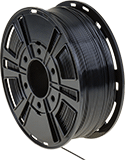
Print tough, long-lasting parts that won’t scratch or wear out from constant motion and friction, such as gears and washers. You can even tap or drill the parts without them cracking or shattering.
Use these filaments with fused filament fabrication (FFF) printers. Because of their relatively high melting point, a heated printer bed is recommended. These filaments also emit fumes when printing, so it’s best to use them in an enclosed printer or to remove the fumes with a fume exhauster. Store them in a sealed container with a desiccant so they don’t absorb moisture in the air, which can make them unusable.
Carbon-fiber-filled nylon filaments make rigid parts that are difficult to bend and break. Their parts can also be threaded and machined more easily than the same filaments without any filler. However, they’re abrasive, so only use them with abrasion-resistant nozzles.
Tensile strength is the best measure of a filament's overall strength. Similar to the stress applied on a rope during a game of tug-of-war, it's the amount of pulling force a material can handle before breaking. A higher rating means a stronger filament. A tensile strength of 5,000 psi and above is considered good; 12,000 psi and above is excellent.
Maximum exposure temperature is the point at which a printed part will begin to deform. Above this temperature, your printed parts will start to lose structural integrity.
Spool | |||||||||||
|---|---|---|---|---|---|---|---|---|---|---|---|
| Dia., mm | Printing Temp. | For Printer Bed Temp. | Tensile Strength | Hardness | Max. Exposure Temp. | For Min. Nozzle Opening Dia., mm | Dia., mm | Dp., mm | Wt., g | Each | |
Carbon Fiber-Filled Nylon Plastic | |||||||||||
Black | |||||||||||
| 1.75 | 280° to 300° C 535° to 570° F | 50° C 122° F | 15,225 psi (Excellent) | Not Rated | 125° C 257° F | 0.4 | 200 | 65 | 500 | 000000 | 000000 |
Flexible TPU 3D Printer Filaments
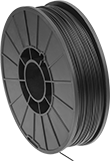 | ||||
Stretchy, soft, and sturdy, these filaments make durable parts that resist breakage despite repeated use. Stronger than ABS and PLA filaments, they create long-lasting parts, such as seals, sleeves, and gaskets, as well as components that take on high-impact forces, such as springs and snap-fit parts. These filaments don't require a heated printer bed, and they won't shrink or warp when cooling. Use them with a fused filament fabrication (FFF) 3D printer. In general, these flexible filaments require a slow feed rate so they don't jam. The softer your filament, the slower your feed rate will need to be. Store them in a sealed container with a desiccant, or use a dehumidifying cabinet, since ambient humidity will cause the plastic to degrade and weaken.
Conductive filaments can be used to create circuit prototypes and other conductive pathways. You can adjust the surface resistivity by changing the temperature of your printer's extruder. As the extruder’s temperature increases, the printed part’s resistivity will decrease.
For the most flexible parts, use durometer 85A filaments. They're more flexible than other TPU filaments. For a quick print without sacrificing flexibility, choose durometer 95A filaments. They print much faster than other TPU filaments.
Tensile strength is the best measure of a filament's overall strength. Similar to the stress applied on a rope during a game of tug-of-war, it's the amount of pulling force a material can handle before breaking. A higher rating means a stronger filament. A tensile strength of 5,000 psi and above is considered good; 12,000 psi and above is excellent.
Maximum exposure temperature is the point at which a printed part will begin to deform. Above this temperature, your printed parts will start to lose structural integrity.
Spool | ||||||||||||
|---|---|---|---|---|---|---|---|---|---|---|---|---|
| Dia., mm | Printing Temp. | For Printer Bed Temp. | Tensile Strength | Surface Resistivity | Max. Exposure Temp. | For Min. Nozzle Opening Dia., mm | Dia., mm | Dp., mm | Wt., g | Choose a Color | Each | |
TPU Plastic—Durometer 85A (Medium Soft) | ||||||||||||
| 1.75 | 225° to 235° C 437° to 455° F | 21° to 40° C 70° to 104° F | 580 psi | __ | 44° C 111° F | 0.25 | 200 | 70 | 1,000 | 00000000 | 000000 | |
| 2.85 | 225° to 235° C 437° to 455° F | 21° to 40° C 70° to 104° F | 580 psi | __ | 44° C 111° F | 0.25 | 200 | 70 | 1,000 | 00000000 | 00000 | |
TPU Plastic—Durometer 95A (Medium Soft) | ||||||||||||
| 1.75 | 230° to 240° C 446° to 464° F | 21° to 40° C 70° to 104° F | 1,250 psi | __ | 49° C 120° F | 0.25 | 200 | 70 | 1,000 | 00000000 | 00000 | |
| 2.85 | 230° to 240° C 446° to 464° F | 21° to 40° C 70° to 104° F | 1,250 psi | __ | 49° C 120° F | 0.25 | 200 | 70 | 1,000 | 00000000 | 00000 | |
Conductive TPU Plastic—Durometer 90A (Medium Soft) | ||||||||||||
| 1.75 | 220° to 230° C 428° to 446° F | 45° C 113° F | 1,700 psi | 1.5 × 103 ohms-cm | Not Rated | 0.4 | 200 | 50 | 1,000 | Opaque Black | 0000000 | 000000 |
| 2.85 | 220° to 230° C 428° to 446° F | 45° C 113° F | 1,700 psi | 1.5 × 103 ohms-cm | Not Rated | 0.4 | 200 | 50 | 1,000 | Opaque Black | 0000000 | 000000 |
Dremel 3D Printer Filaments
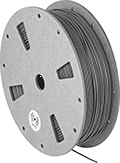
Build parts and prototypes from these filaments using Dremel fused filament fabrication (FFF) 3D printers. An RFID tag on the spool communicates with your printer, automatically adjusting it to the correct temperature and print speed for the filament material and notifying you when the filament is running out.
Nylon resists scratches and wear, and is often used to create parts that encounter constant friction such as gears or bearings. Nylon parts also won’t crack or shatter when they’re drilled or tapped. Exposure to humidity makes these filaments brittle and unusable, so they need to be stored in a sealed container with a desiccant. Like ECO-ABS, parts can warp during cooling and need a heated printer bed. Make sure your printer is connected to a ventilation system, as nylon emits fumes during printing.
Tensile strength is the best measure of a filament's overall strength. Similar to the stress applied on a rope during a game of tug-of-war, it's the amount of pulling force a material can handle before breaking. A higher rating means a stronger filament. A tensile strength of 5,000 psi and above is considered good; 12,000 psi and above is excellent.
Maximum exposure temperature is the point at which a printed part will begin to deform. Above this temperature, your printed parts will start to lose structural integrity.
Spool | ||||||||||||
|---|---|---|---|---|---|---|---|---|---|---|---|---|
| Manufacturer Model No. | Dia., mm | Printing Temp. | For Printer Bed Temp. | Tensile Strength | Max. Exposure Temp. | For Min. Nozzle Opening Dia., mm | Dia., mm | Dp., mm | Wt., g | Color | Each | |
Nylon Plastic | ||||||||||||
| DF45-NYP-B | 1.75 | 230° to 250° C 446° to 482° F | 80° C 176° F | 7,540 psi (Good) | 155° C 311° F | 0.4 | 180 | 55 | 500 | Black | 0000000 | 000000 |
Moisture-Resistant Polyester 3D Printer Filaments
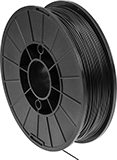
Parts printed with these polyester filaments absorb less moisture than other types of plastic, making them ideal for use in wet or humid environments. They are more durable and flexible than PLA, and easier to print than ABS. Use these filaments with fused filament fabrication (FFF) 3D printers, and print onto a heated print bed. Printing onto a cool surface causes the molten filament to change temperature rapidly, which can warp your designs. Although finished parts are moisture-resistant, these filaments are sensitive to humidity, and should be stored in a dehumidifying cabinet or a sealed container with desiccant for the best printing quality.
PCTG is more impact resistant than PETT and PETG and holds up to a wide range of acids and bases without breaking down. It is often used for printing parts that will be exposed to chemicals and oils.
Tensile strength is the best measure of a filament's overall strength. Similar to the stress applied on a rope during a game of tug-of-war, it's the amount of pulling force a material can handle before breaking. A higher rating means a stronger filament. A tensile strength of 5,000 psi and above is considered good; 12,000 psi and above is excellent.
Maximum exposure temperature is the point at which a printed part will begin to deform. Above this temperature, your printed parts will start to lose structural integrity.
Spool | |||||||||||
|---|---|---|---|---|---|---|---|---|---|---|---|
| Dia., mm | Printing Temp. | For Printer Bed Temp. | Tensile Strength | Hardness | Max. Exposure Temp. | For Min. Nozzle Opening Dia., mm | Dia., mm | Dp., mm | Wt., g | Each | |
PCTG Plastic | |||||||||||
Clear | |||||||||||
| 1.75 | 250° to 270° C 482° to 518° F | 70° to 80° C 158° to 176° F | 5,510 psi (Good) | Not Rated | 70° C 158° F | 0.25 | 200 | 68 | 1,000 | 00000000 | 000000 |
| 2.85 | 250° to 270° C 482° to 518° F | 70° to 80° C 158° to 176° F | 5,510 psi (Good) | Not Rated | 70° C 158° F | 0.25 | 200 | 68 | 1,000 | 00000000 | 00000 |
Foam-Forming 3D Printer Filaments
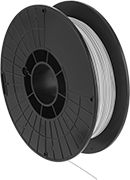
Print these polypropylene filaments into filters, gaskets, and other lightweight, foam-like parts that let air and gas pass through but repel water. They contain a filler that dissolves in water, forming hollow spaces that make up 45% of the part. Polypropylene is known for being rigid yet flexible, so it absorbs impacts and bounces back to shape after bending, making these filaments good for compressible seals and living hinges. It also resists hydrocholoric and phosphoric acids, as well as other nonoxidizing acids and bases.
These filaments work with fused filament fabrication (FFF) 3D printers. If using a glass print surface, apply an adhesive to prevent the filament from detaching. The recommended print speed is 25 mm/s. While polypropylene is likely to shrink, the filler in these filaments supports your design, preventing it from losing shape as it prints. Submerge your part in hot water for about 24 hours after printing to dissolve the filler and expose the pores.
For extra support when printing complex designs, use structural support 3D printer filaments. They dissolve in water at the same time as this filament’s filler.
Spool | |||||||||||||
|---|---|---|---|---|---|---|---|---|---|---|---|---|---|
| Dia., mm | Printing Temp. | For Printer Bed Temp. | Tensile Strength | Hardness | Max. Exposure Temp. | For Min. Nozzle Opening Dia., mm | Dia., mm | Dp., mm | Material | Wt., g | Color | Each | |
Polypropylene Plastic | |||||||||||||
| 1.75 | 190° to 240° C 374° to 464° F | 95° C to 125° C 203° F to 257° F | 1,000 psi (Poor) | Shore A90 (Medium Soft) | 140° C 284° F | 0.4 | 200 | 55 | Plastic | 500 | White | 0000000 | 0000000 |
| 2.85 | 190° to 240° C 374° to 464° F | 95° C to 125° C 203° F to 257° F | 1,000 psi (Poor) | Shore A90 (Medium Soft) | 140° C 284° F | 0.4 | 200 | 55 | Plastic | 500 | White | 0000000 | 000000 |



























